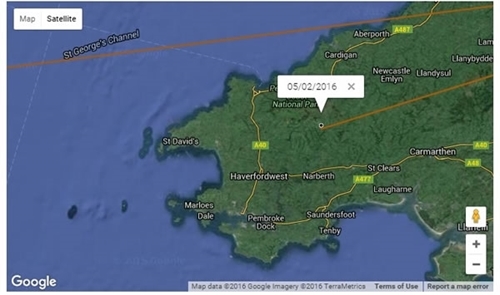By Chris Heward, Wetlands Research Assistant
This week the Woodcock Watch team is down in Cornwall on one of our annual woodcock-catching trips. This long-running ringing project maintains a ‘marked’ sample of woodcock in which individuals can be identified by a metal leg ring.
There’s a wealth of things that we can learn from a study of this nature including an assessment of average body condition, an estimate of woodcock density, a measure of adult:juvenile ratios and, over time, annual variation in all of the above. We’ll post more about the progress of our trip when we return to Hampshire next week.

One of the nice things about this trip is the opportunity to get out of the office and spend some time away from the computer – it’s a welcome chance to spend some time offline! Nevertheless, we’re glad we can check the Woodcock Watch website from time to time, as today we’ve received some interesting new data from one of our satellite-tagged woodcock!
Nastasia was caught and tagged in Ireland in the winter of 2013/14. She’s a Russian breeding bird that has regularly trekked between County Cork and a breeding site close to Lake Ladoga in North-Western Russia. The last time we heard from Nastasia was on the 22nd December when she was in Pembrokeshire – assumedly on her way back to Ireland.
Back then I wrote this blog on Nastasia’s travels and concluded that… “We can only assume that Nastasia’s final destination will be her usual County Cork wintering site. It may be that she will choose to spend the entire winter in her current Welsh location if conditions remain as they are. It will be interesting to observe, if and when she makes the hop over to Ireland, the weather that this final stage of her migration coincides with.”
Nastasia’s latest location seems to answer this question, with data received on the 5th February showing that she has remained in Pembrokeshire this winter. This interesting observation contradicts what we often tend to say about the faithfulness of woodcock to a single wintering site.
In fact, we are finding plenty of evidence to suggest that, whilst many woodcock are faithful to a single wintering site, some individuals show a surprising degree of adaptability.
We suspect that this flexibility allows the birds to react to different types of winter weather. In a very harsh winter, sites in the far south and west of the British Isles may be preferable as prolonged periods of ground frost are less likely in these regions.
In a mild winter, on the other hand, when such a long migration is unnecessary, many birds may complete just part of their usual journey – potentially saving themselves several hundreds of miles of costly flight.
This conclusion appears to be supported by our observations here in Cornwall this week. Whilst we are still finding plenty of birds to ring this year, average densities have definitely been higher in past winters when the weather elsewhere in the UK was colder.
Like Nastasia, many of Cornwall’s regular winter visitors are getting away with shorter-than-average migrations and making the most of unseasonably mild conditions further north and east.
Please help our declining UK woodcock